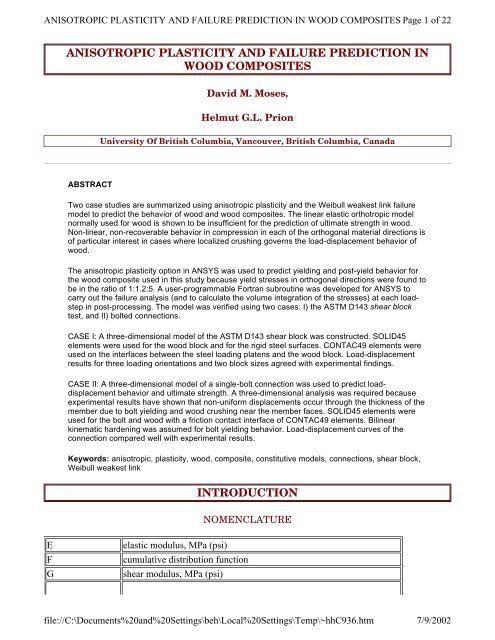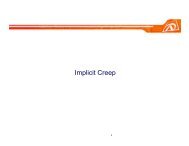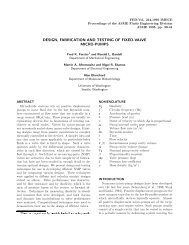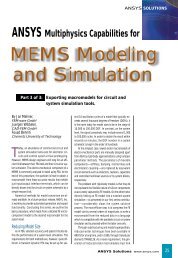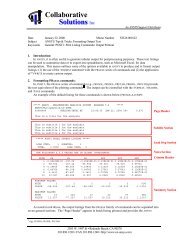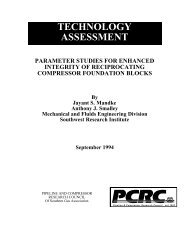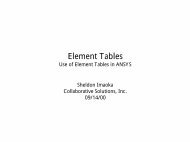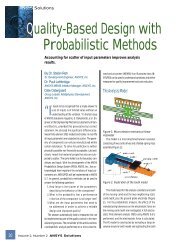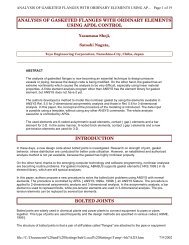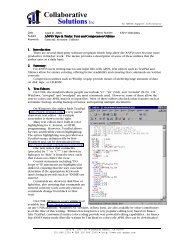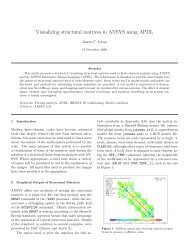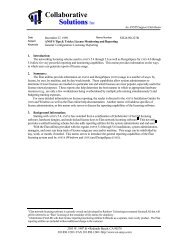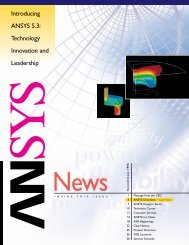anisotropic plasticity and failure prediction in wood ... - ANSYS Users
anisotropic plasticity and failure prediction in wood ... - ANSYS Users
anisotropic plasticity and failure prediction in wood ... - ANSYS Users
You also want an ePaper? Increase the reach of your titles
YUMPU automatically turns print PDFs into web optimized ePapers that Google loves.
ANISOTROPIC PLASTICITY AND FAILURE PREDICTION IN WOOD COMPOSITES Page 1 of 22<br />
ANISOTROPIC PLASTICITY AND FAILURE PREDICTION IN<br />
WOOD COMPOSITES<br />
ABSTRACT<br />
David M. Moses,<br />
Helmut G.L. Prion<br />
University Of British Columbia, Vancouver, British Columbia, Canada<br />
Two case studies are summarized us<strong>in</strong>g <strong>anisotropic</strong> <strong>plasticity</strong> <strong>and</strong> the Weibull weakest l<strong>in</strong>k <strong>failure</strong><br />
model to predict the behavior of <strong>wood</strong> <strong>and</strong> <strong>wood</strong> composites. The l<strong>in</strong>ear elastic orthotropic model<br />
normally used for <strong>wood</strong> is shown to be <strong>in</strong>sufficient for the <strong>prediction</strong> of ultimate strength <strong>in</strong> <strong>wood</strong>.<br />
Non-l<strong>in</strong>ear, non-recoverable behavior <strong>in</strong> compression <strong>in</strong> each of the orthogonal material directions is<br />
of particular <strong>in</strong>terest <strong>in</strong> cases where localized crush<strong>in</strong>g governs the load-displacement behavior of<br />
<strong>wood</strong>.<br />
The <strong>anisotropic</strong> <strong>plasticity</strong> option <strong>in</strong> <strong>ANSYS</strong> was used to predict yield<strong>in</strong>g <strong>and</strong> post-yield behavior for<br />
the <strong>wood</strong> composite used <strong>in</strong> this study because yield stresses <strong>in</strong> orthogonal directions were found to<br />
be <strong>in</strong> the ratio of 1:1.2:5. A user-programmable Fortran subrout<strong>in</strong>e was developed for <strong>ANSYS</strong> to<br />
carry out the <strong>failure</strong> analysis (<strong>and</strong> to calculate the volume <strong>in</strong>tegration of the stresses) at each loadstep<br />
<strong>in</strong> post-process<strong>in</strong>g. The model was verified us<strong>in</strong>g two cases: I) the ASTM D143 shear block<br />
test, <strong>and</strong> II) bolted connections.<br />
CASE I: A three-dimensional model of the ASTM D143 shear block was constructed. SOLID45<br />
elements were used for the <strong>wood</strong> block <strong>and</strong> for the rigid steel surfaces. CONTAC49 elements were<br />
used on the <strong>in</strong>terfaces between the steel load<strong>in</strong>g platens <strong>and</strong> the <strong>wood</strong> block. Load-displacement<br />
results for three load<strong>in</strong>g orientations <strong>and</strong> two block sizes agreed with experimental f<strong>in</strong>d<strong>in</strong>gs.<br />
CASE II: A three-dimensional model of a s<strong>in</strong>gle-bolt connection was used to predict loaddisplacement<br />
behavior <strong>and</strong> ultimate strength. A three-dimensional analysis was required because<br />
experimental results have shown that non-uniform displacements occur through the thickness of the<br />
member due to bolt yield<strong>in</strong>g <strong>and</strong> <strong>wood</strong> crush<strong>in</strong>g near the member faces. SOLID45 elements were<br />
used for the bolt <strong>and</strong> <strong>wood</strong> with a friction contact <strong>in</strong>terface of CONTAC49 elements. Bil<strong>in</strong>ear<br />
k<strong>in</strong>ematic harden<strong>in</strong>g was assumed for bolt yield<strong>in</strong>g behavior. Load-displacement curves of the<br />
connection compared well with experimental results.<br />
Keywords: <strong>anisotropic</strong>, <strong>plasticity</strong>, <strong>wood</strong>, composite, constitutive models, connections, shear block,<br />
Weibull weakest l<strong>in</strong>k<br />
E elastic modulus, MPa (psi)<br />
INTRODUCTION<br />
NOMENCLATURE<br />
F cumulative distribution function<br />
G shear modulus, MPa (psi)<br />
file://C:\Documents%20<strong>and</strong>%20Sett<strong>in</strong>gs\beh\Local%20Sett<strong>in</strong>gs\Temp\~hhC936.htm<br />
7/9/2002
ANISOTROPIC PLASTICITY AND FAILURE PREDICTION IN WOOD COMPOSITES Page 2 of 22<br />
I <strong>in</strong>tegral function<br />
[J] Jacobian<br />
K normalization parameter, MPa 2 , (psi 2 )<br />
K IC , K IIC<br />
fracture toughness, MN/m 3/2 (ksiv<strong>in</strong>)<br />
[M] describes yield surface<br />
N number of <strong>in</strong>tegration po<strong>in</strong>ts<br />
{N} shape functions<br />
P load, kN (lbs)<br />
W weight<strong>in</strong>g value for Gauss <strong>in</strong>tegration<br />
d diameter, mm (<strong>in</strong>.)<br />
k shape parameter of Weibull distribution<br />
l length, mm (<strong>in</strong>.)<br />
m scale parameter of Weibull distribution<br />
p probability level<br />
w width, mm (<strong>in</strong>.)<br />
x, y, z material directions <strong>in</strong> global co-ord<strong>in</strong>ates<br />
ratio of true ultimate stress to assumed<br />
coefficient of friction<br />
stress or normal stress, MPa (psi)<br />
shear stress, MPa (psi)<br />
, , normalized local co-ord<strong>in</strong>ates<br />
Subscripts<br />
i, j, r counters<br />
x, y, z, q material directions<br />
1, 2, ... counters<br />
+,- tension, compression<br />
Superscripts<br />
* reference value<br />
Few constitutive models for l<strong>in</strong>ear <strong>and</strong> non-l<strong>in</strong>ear stress-stra<strong>in</strong> behavior exist for <strong>wood</strong>. F<strong>in</strong>d<strong>in</strong>g a suitable material<br />
model for <strong>wood</strong> will allow analysts to predict its behavior <strong>in</strong> numerous applications <strong>in</strong> structural eng<strong>in</strong>eer<strong>in</strong>g<br />
without the reliance on extensive empirical tests. Such a model would represent the true stress-stra<strong>in</strong> behavior of<br />
<strong>wood</strong> <strong>and</strong> lead to <strong>prediction</strong>s of ultimate strength for numerous applications such as the behavior of connections<br />
<strong>in</strong> solid <strong>wood</strong> <strong>and</strong> <strong>in</strong> <strong>wood</strong> composites. In addition, the development of <strong>wood</strong> composites will benefit from<br />
model<strong>in</strong>g through the <strong>prediction</strong> of the effects of modified lay-ups on stress-stra<strong>in</strong> <strong>and</strong> ultimate strength<br />
characteristics.<br />
The focus of this paper is the development <strong>and</strong> verification of one such model which has been proposed for use<br />
with bolted connections <strong>in</strong> solid lumber <strong>and</strong> lam<strong>in</strong>ated str<strong>and</strong> lumber (a <strong>wood</strong> composite panel product). Wood<br />
composite panels for structural applications tend to be similar to solid <strong>wood</strong> <strong>in</strong> structure but have improved<br />
strength properties which are associated with less variability than solid <strong>wood</strong>. The structure of solid <strong>wood</strong> is,<br />
therefore, the basis for its material models.<br />
file://C:\Documents%20<strong>and</strong>%20Sett<strong>in</strong>gs\beh\Local%20Sett<strong>in</strong>gs\Temp\~hhC936.htm<br />
7/9/2002
ANISOTROPIC PLASTICITY AND FAILURE PREDICTION IN WOOD COMPOSITES Page 3 of 22<br />
Wood structure <strong>and</strong> material behavior<br />
In a tree, cells are oriented with their long axes parallel to the height of the tree. Each year, a layer of <strong>wood</strong> cells,<br />
known as the annual r<strong>in</strong>g, is added directly below the bark. The result is a difference <strong>in</strong> properties parallel to the<br />
long axis, <strong>and</strong> perpendicular to this axis, thereby mak<strong>in</strong>g this an <strong>anisotropic</strong> material. Property differences<br />
between the radial <strong>and</strong> tangential directions (relative to the core of a log) have resulted <strong>in</strong> <strong>wood</strong> be<strong>in</strong>g classified<br />
as a radially orthotropic material especially with respect to <strong>in</strong>dividual pieces of lumber cut from a log.<br />
Values of elastic <strong>and</strong> shear moduli are very different <strong>in</strong> each of the three orthotropic directions. Douglas fir, for<br />
example, has a ratio of elastic moduli <strong>in</strong> each of the primary directions of roughly 1:1.5:18 where the highest<br />
stiffness is <strong>in</strong> the direction parallel-to-gra<strong>in</strong>. The ratio for shear moduli <strong>in</strong> each of the primary shear planes is<br />
approximately 1:12:15. Large variations <strong>in</strong> these ratios exist between species. Stress-stra<strong>in</strong> behavior is non-l<strong>in</strong>ear<br />
<strong>in</strong> compression due to crush<strong>in</strong>g of cells <strong>and</strong> separation of fibers. In tension, however, stress-stra<strong>in</strong> is l<strong>in</strong>ear until<br />
brittle <strong>failure</strong> occurs. The same is true of shear. Ultimate tension strength can be more than twenty times greater<br />
parallel-to-gra<strong>in</strong> than perpendicular-to-gra<strong>in</strong>, whereas compression strength perpendicular-to-gra<strong>in</strong> can be more<br />
than three times greater than parallel-to-gra<strong>in</strong> strength. Wood composites can be manufactured to modify these<br />
properties through the orientation of fibers <strong>and</strong> the use of multiple layers.<br />
Lam<strong>in</strong>ated Str<strong>and</strong> Lumber (LSL)<br />
Lam<strong>in</strong>ated str<strong>and</strong> lumber is a composite structural material consist<strong>in</strong>g of oriented Aspen flakes, glued <strong>and</strong><br />
compressed to form panels up to 90 mm (3 1/2 <strong>in</strong>ches) thick. This material is an attractive alternative to solid<br />
sawn lumber because it has stronger properties than solid lumber of the same species as well as less variability.<br />
It can be produced from smaller diameter low quality trees thereby reduc<strong>in</strong>g our dependence on old growth<br />
forests. LSL can be produced to specific f<strong>in</strong>al properties by controll<strong>in</strong>g variables related to the str<strong>and</strong>ed lumber,<br />
res<strong>in</strong>s, <strong>and</strong> press<strong>in</strong>g cycle. As the properties of the material are improved, efficiency <strong>in</strong> design of structures us<strong>in</strong>g<br />
LSL is limited only by the capacity of these <strong>wood</strong> members at their connections to other structural components.<br />
This limitation currently results <strong>in</strong> very conservative build<strong>in</strong>g designs that do not utilize the maximum strength<br />
capacity of the members. Improvements <strong>in</strong> this area can only be achieved with a comprehensive stress analysis<br />
of the material at its connections with other members.<br />
Aspen LSL was used for this study. The size of each str<strong>and</strong> was approximately 30.5 cm (12 <strong>in</strong>ches) long, 2.5 cm<br />
(1 <strong>in</strong>ch) wide, <strong>and</strong> less than 1 mm (0.037 <strong>in</strong>ches) thick. Highly oriented panels were produced specifically for this<br />
study. An extensive series of tests were performed to determ<strong>in</strong>e the elastic properties <strong>and</strong> ultimate strengths <strong>in</strong><br />
tension <strong>and</strong> compression, as shown <strong>in</strong> Table 1. The ratio of elastic moduli was approximately 1:7:130 while the<br />
ratio of ultimate strengths <strong>in</strong> each direction was roughly 1:95:411 <strong>in</strong> compression <strong>and</strong> 1:4:39 <strong>in</strong> tension. These<br />
large ratios <strong>in</strong>dicate the highly orthotropic nature of this material. Shear moduli were not measured <strong>in</strong> this study<br />
but can be assumed from previous studies (Hunt et al., 1985, Hoover et al., 1992, <strong>and</strong> Bradtmueller et al., 1997),<br />
as shown <strong>in</strong> Table 2.<br />
Table 1. Properties of LSL determ<strong>in</strong>ed from experiments<br />
Tension E (psi) k<br />
m*<br />
(unit vol.)<br />
* (V=V*=1,<br />
p=0.5)<br />
No. of<br />
replicates<br />
X 95,000 4.5 747 689 30<br />
Y 1,700,000 5.7 8150 7642 30<br />
Z 13,000 6.4 207 195 30<br />
Compression E (psi) E tangent (psi) yield (psi)<br />
Avg. ultimate<br />
(psi)<br />
No. of<br />
replicates<br />
X 95,000 31,000 1020 1238 10<br />
Y 1,700,000 1,150,000 4009 5346 10<br />
file://C:\Documents%20<strong>and</strong>%20Sett<strong>in</strong>gs\beh\Local%20Sett<strong>in</strong>gs\Temp\~hhC936.htm<br />
7/9/2002
ANISOTROPIC PLASTICITY AND FAILURE PREDICTION IN WOOD COMPOSITES Page 4 of 22<br />
Z 13,000 6,000 620 - 10<br />
Shear Vol. (cu.<strong>in</strong>.)<br />
Avg. ultimate<br />
load (lbs.)<br />
Table 2. Shear properties of LSL based on studies by others<br />
Avg. ultimate<br />
displacement<br />
(<strong>in</strong>.)<br />
PREVIOUS MATERIAL MODELS<br />
Stress-stra<strong>in</strong> behavior<br />
Early analyses of orthotropic plates with p<strong>in</strong>-loaded holes emphasized the performance of contact elements on<br />
the boundary between the p<strong>in</strong> <strong>and</strong> the plate <strong>and</strong> assumed l<strong>in</strong>ear elastic properties for the plate (Wilk<strong>in</strong>son et al.,<br />
1981, Hyer et al., 1987). Rahman et al. (1991) performed a two-dimensional analysis of a p<strong>in</strong> <strong>in</strong> a hole <strong>in</strong> an<br />
orthotropic <strong>wood</strong> plate but added material non-l<strong>in</strong>earity due to crush<strong>in</strong>g of <strong>wood</strong> fibers to determ<strong>in</strong>e the stress<br />
distribution around the hole. They showed that a non-l<strong>in</strong>ear compression model parallel-to-gra<strong>in</strong> (with p<strong>in</strong> load<strong>in</strong>g<br />
parallel-to-gra<strong>in</strong>) resulted <strong>in</strong> improved stress <strong>prediction</strong>s along the region beg<strong>in</strong>n<strong>in</strong>g under the bolt <strong>and</strong> extend<strong>in</strong>g<br />
to the end of the specimen. These results corresponded to measured Moiré fr<strong>in</strong>ge patterns.<br />
Patton-Mallory et al. (1997) performed a non-l<strong>in</strong>ear elastic analysis <strong>in</strong> three-dimensions for a model of a s<strong>in</strong>gle<br />
bolt <strong>in</strong> a piece of Douglas fir. The geometry of this model is described <strong>in</strong> section 5. The tri-l<strong>in</strong>ear elastic stressstra<strong>in</strong><br />
behavior assumed for this model <strong>and</strong> shown <strong>in</strong> Figure 1 for normal stress parallel-to-gra<strong>in</strong>, resulted <strong>in</strong> very<br />
good load-displacement <strong>prediction</strong>s compared to experimental results. The crush<strong>in</strong>g of fibers parallel-to-gra<strong>in</strong><br />
most <strong>in</strong>fluenced the displacement of the bolt relative to the piece of <strong>wood</strong>, thus, the tri-l<strong>in</strong>ear model proved useful<br />
for load-displacement <strong>prediction</strong>s of connections. However, as was <strong>in</strong>dicated by Patton-Mallory et al. (1997),<br />
improvements are still required <strong>in</strong> the material model for <strong>wood</strong>.<br />
k<br />
No. of<br />
replicates<br />
XY - big 6.9 5054 0.07 10.6 15<br />
XY - small 3.2 2300 0.06 10.6 20<br />
YZ - big 6.8 2302 0.03 7.4 15<br />
YZ - big 3.4 1674 0.03 7.4 15<br />
XZ - small 6.8 1490 0.06 6.9 16<br />
XZ - small 3.4 701 0.06 6.9 14<br />
Poisson's Ratios Value<br />
No. of<br />
replicates<br />
XY 0.048 10<br />
YZ 0.993 10<br />
XZ 0.351 10<br />
Interlam<strong>in</strong>ar Shear<br />
G YZ parallel (psi) 61,000<br />
G XZ perpendicular (psi) 26,000<br />
Edgewise Shear<br />
G XY (psi) 200,000<br />
file://C:\Documents%20<strong>and</strong>%20Sett<strong>in</strong>gs\beh\Local%20Sett<strong>in</strong>gs\Temp\~hhC936.htm<br />
7/9/2002
ANISOTROPIC PLASTICITY AND FAILURE PREDICTION IN WOOD COMPOSITES Page 5 of 22<br />
Two drawbacks were associated with the tri-l<strong>in</strong>ear elastic model. Firstly, at high stra<strong>in</strong>s, negative terms were<br />
found to develop on the ma<strong>in</strong> diagonal of the stiffness matrix if similar tri-l<strong>in</strong>ear elastic behavior was used <strong>in</strong> the<br />
two other orthotropic material directions <strong>in</strong> compression. As a result, non-l<strong>in</strong>earity <strong>in</strong> the shear stress-stra<strong>in</strong><br />
behavior was <strong>in</strong>troduced to improve the numerical stability of the model. Secondly, the <strong>prediction</strong> of stresses <strong>in</strong><br />
the perpendicular-to-gra<strong>in</strong> directions was <strong>in</strong>accurate, as discussed by Moses <strong>and</strong> Prion (1999), which meant that<br />
ultimate strength of the connection could not be well predicted. Part of the problem with the elastic model was its<br />
<strong>in</strong>ability to account for the energy dissipation associated with the non-recoverable deformations due to <strong>wood</strong><br />
crush<strong>in</strong>g. Plasticity models prevent this form of <strong>in</strong>stability from occurr<strong>in</strong>g. For the current study, it was proposed<br />
that the behavior <strong>in</strong> compression be modeled with the <strong>anisotropic</strong> <strong>plasticity</strong> model, while tension <strong>and</strong> shear<br />
behavior rema<strong>in</strong> l<strong>in</strong>ear elastic, until reach<strong>in</strong>g ultimate <strong>failure</strong>.<br />
Figure 1. TRI-LINEAR STRESS-STRAIN CURVE FOR COMPRESSION BEHAVIOR PARALLEL-TO-GRAIN<br />
Failure behavior<br />
Wood is brittle <strong>in</strong> tension <strong>and</strong> shear. Methods such as fracture mechanics <strong>and</strong> <strong>failure</strong> envelopes can be used to<br />
predict the po<strong>in</strong>t at which brittle <strong>failure</strong> occurs. Stress based criteria are typically used for <strong>wood</strong>.<br />
Fracture mechanics <strong>in</strong> <strong>wood</strong> can be used to predict ultimate strength <strong>in</strong> mixed-mode tension/shear stress fields. A<br />
crack can start <strong>in</strong> any direction but will always turn to the direction with the lowest fracture toughness. In <strong>wood</strong>,<br />
this is normally the direction along the gra<strong>in</strong> because the fracture toughness <strong>in</strong> other directions is approximately<br />
ten times greater. There is, however, some question about the accuracy <strong>in</strong> the determ<strong>in</strong>ation of the fracture<br />
toughness constants K IC <strong>and</strong> K IIC for mixed-mode <strong>failure</strong> <strong>in</strong> <strong>wood</strong> (Fonselius <strong>and</strong> Riipola 1992). In addition to<br />
difficulties <strong>in</strong> determ<strong>in</strong><strong>in</strong>g the fracture toughness constants, there is little <strong>in</strong>formation available on more complex<br />
criteria for three-dimensional mixed-mode stress cases. To simplify the model<strong>in</strong>g <strong>and</strong> solution processes, <strong>and</strong><br />
reduce the number of tests required to determ<strong>in</strong>e strength parameters, the theory of fracture mechanics was not<br />
selected for the current study.<br />
The Maximum Stress criterion is assumed for the current study. Ultimate strengths <strong>in</strong> tension <strong>and</strong> shear are<br />
predicted us<strong>in</strong>g the Weibull weakest l<strong>in</strong>k theory for size effects, while the <strong>plasticity</strong> model allows for <strong>in</strong>creas<strong>in</strong>g<br />
stra<strong>in</strong>s <strong>in</strong> compression beyond the assigned yield stresses. Tensor polynomial criteria such as the Tsai-Wu (Tsai<br />
<strong>and</strong> Wu 1971) criterion can be used to relate ultimate strengths <strong>in</strong> tension, compression <strong>and</strong> shear to the current<br />
state of stress <strong>in</strong> two-dimensional models of composites. In three-dimensions, however, the determ<strong>in</strong>ation of the<br />
<strong>in</strong>teraction terms required for this model can be difficult or impossible if all stress comb<strong>in</strong>ations are considered.<br />
CURRENT MODEL<br />
Anisotropic Plasticity<br />
The <strong>anisotropic</strong> <strong>plasticity</strong> material model has been used to predict <strong>failure</strong> of non-<strong>wood</strong> composites <strong>in</strong> twodimensional<br />
f<strong>in</strong>ite element models at the University of British Columbia, Canada (Vaziri 1991). In the current<br />
application, the <strong>anisotropic</strong> <strong>plasticity</strong> model was applied <strong>in</strong> three-dimensions us<strong>in</strong>g the TB,ANISO option <strong>in</strong><br />
<strong>ANSYS</strong> v.5.3. As <strong>in</strong>dicated <strong>in</strong> the <strong>ANSYS</strong> Theory Manual (<strong>ANSYS</strong> 1992), this model is based upon the yield<br />
criterion by Hill (1947) for orthotropic materials. Different compression <strong>and</strong> tension yield stresses <strong>in</strong> each direction<br />
are h<strong>and</strong>led by changes proposed by Shih <strong>and</strong> Lee (1978) <strong>and</strong> the work harden<strong>in</strong>g model of Valliappan et al.<br />
(1976). An associative flow rule is assumed. A sample stress-stra<strong>in</strong> curve is shown <strong>in</strong> Figure 2 <strong>in</strong>dicat<strong>in</strong>g the yield<br />
stress <strong>and</strong> tangent modulus for one material direction. The two other normal stress-stra<strong>in</strong> curves <strong>and</strong> three shear<br />
file://C:\Documents%20<strong>and</strong>%20Sett<strong>in</strong>gs\beh\Local%20Sett<strong>in</strong>gs\Temp\~hhC936.htm<br />
7/9/2002
ANISOTROPIC PLASTICITY AND FAILURE PREDICTION IN WOOD COMPOSITES Page 6 of 22<br />
stress-stra<strong>in</strong> curves are also required for this model. This results <strong>in</strong> eighteen additional constants beyond the n<strong>in</strong>e<br />
required for orthotropic elastic materials.<br />
Figure 2. BI-LINEAR STRESS-STRAIN CURVE FOR NORMAL STRESS IN ANISOTROPIC PLASTICITY<br />
MODEL<br />
Two criteria must be satisfied when us<strong>in</strong>g this model. To satisfy the requirement for plastic <strong>in</strong>compressibility, the<br />
yield stresses +i <strong>and</strong> -i <strong>in</strong> tension <strong>and</strong> compression, respectively, <strong>in</strong> direction i are <strong>in</strong>ter-related:<br />
(1)<br />
To ma<strong>in</strong>ta<strong>in</strong> a closed yield surface:<br />
(2)<br />
where:<br />
, (i = 1, 2, 3) (3)<br />
<strong>and</strong><br />
. (4)<br />
Equation (2) must be satisfied at all levels of stra<strong>in</strong> s<strong>in</strong>ce the yield stresses will change as work harden<strong>in</strong>g<br />
proceeds. These restrictions on allowable yield stresses <strong>and</strong> tangent moduli make fitt<strong>in</strong>g of experimental results<br />
difficult. This is particularly true for highly orthotropic materials. Mak<strong>in</strong>g the yield stresses <strong>and</strong> tangent moduli<br />
file://C:\Documents%20<strong>and</strong>%20Sett<strong>in</strong>gs\beh\Local%20Sett<strong>in</strong>gs\Temp\~hhC936.htm<br />
7/9/2002
ANISOTROPIC PLASTICITY AND FAILURE PREDICTION IN WOOD COMPOSITES Page 7 of 22<br />
more equal <strong>in</strong>creases the chances of satisfy<strong>in</strong>g these equations. Equation (1) is better satisfied if the yield<br />
stresses <strong>in</strong> tension <strong>and</strong> compression are set equal to each other for each direction. To assist <strong>in</strong> determ<strong>in</strong><strong>in</strong>g these<br />
values, a spreadsheet was developed us<strong>in</strong>g an optimization algorithm to satisfy these conditions up to 20%<br />
plastic stra<strong>in</strong>.<br />
The fitted stress-stra<strong>in</strong> curves assumed for LSL <strong>in</strong> each direction <strong>in</strong> compression are shown <strong>in</strong> Figure 3 along with<br />
experimental uniaxial stress-stra<strong>in</strong> curves. Values for the model are listed <strong>in</strong> Table 3. It was found that equations<br />
(1) <strong>and</strong> (2) were best satisfied when tension <strong>and</strong> compression yield stresses were set equal for each direction of<br />
normal stress. The shear yield stress was set high to prevent yield<strong>in</strong>g <strong>in</strong> shear. At this po<strong>in</strong>t, it was assumed that<br />
tension behavior would be allowed to follow the bi-l<strong>in</strong>ear stress-stra<strong>in</strong> curve with yield<strong>in</strong>g. This is possible s<strong>in</strong>ce<br />
brittle <strong>failure</strong> <strong>in</strong> tension will occur below the yield po<strong>in</strong>t <strong>in</strong> the critical X <strong>and</strong> Z directions for the two cases<br />
discussed <strong>in</strong> this paper.<br />
Table 3. Properties used <strong>in</strong> model for normal stresses<br />
Direction E (psi) E tangent (psi) yield (psi)<br />
X 95,000 4452 960<br />
Y 1,700,000 50,000 3500<br />
Z 13,000 3617 810<br />
Figure 3. STRESS-STRAIN EXPERIMENTAL CURVES FOR COMPRESSION BEHAVIOR SHOWING<br />
ASSUMED ANISOTROPIC PLASTICITY CURVES.<br />
(Y-DIRECTION IS PARALLEL TO AXIS OF GRAIN)<br />
file://C:\Documents%20<strong>and</strong>%20Sett<strong>in</strong>gs\beh\Local%20Sett<strong>in</strong>gs\Temp\~hhC936.htm<br />
7/9/2002
ANISOTROPIC PLASTICITY AND FAILURE PREDICTION IN WOOD COMPOSITES Page 8 of 22<br />
Size Effects<br />
The Weibull weakest l<strong>in</strong>k theory postulates that for brittle materials, larger specimens are more likely to fail at<br />
lower stresses due to the <strong>in</strong>creased probability of a flaw <strong>in</strong> that larger specimen volume. Barrett (1974) found this<br />
to be true for the ultimate tension stress perpendicular-to-gra<strong>in</strong> <strong>in</strong> Douglas fir. This concept was used to develop<br />
lumber strength design values for the Canadian st<strong>and</strong>ard for Eng<strong>in</strong>eer<strong>in</strong>g Design <strong>in</strong> Wood (O86.1, 1995). It has<br />
also been used to determ<strong>in</strong>e the strength of timber rivet connections listed <strong>in</strong> the st<strong>and</strong>ard (Foschi <strong>and</strong> Longworth,<br />
1975).<br />
The probability of brittle <strong>failure</strong> based on a two-parameter Weibull distribution is a function of the stress<br />
distribution over the volume of material:<br />
file://C:\Documents%20<strong>and</strong>%20Sett<strong>in</strong>gs\beh\Local%20Sett<strong>in</strong>gs\Temp\~hhC936.htm<br />
7/9/2002
ANISOTROPIC PLASTICITY AND FAILURE PREDICTION IN WOOD COMPOSITES Page 9 of 22<br />
(5)<br />
where F is the probability of <strong>failure</strong>, V* is a reference volume, k is the shape parameter, m is the scale parameter<br />
associated with the reference volume, <strong>and</strong> is the stress (tension or shear, <strong>in</strong> any given direction or plane,<br />
respectively). The reference stress is based on experimental results shown <strong>in</strong> Table 1.<br />
(6)<br />
is the <strong>failure</strong> stress for a given probability of <strong>failure</strong>, p. It can be shown that <strong>failure</strong> occurs when the reference<br />
stress, *, occurr<strong>in</strong>g over volume V*, satisfies the follow<strong>in</strong>g <strong>in</strong>equality which relates a variable state of stress over<br />
an arbitrary volume to the reference stress:<br />
(7)<br />
This form is similar to the Maximum Stress criterion where each stress is treated <strong>in</strong>dividually <strong>and</strong> stress<br />
<strong>in</strong>teractions are assumed to have little or no effect. When the stress field is constant over a volume, equation (7)<br />
can be simplified to give the <strong>failure</strong> stresses for a given probability level, p:<br />
(8)<br />
where 1 <strong>and</strong> 2 are the strengths of specimens of volumes, V 1 <strong>and</strong> V 2 , respectively.<br />
This theory was implemented <strong>in</strong> <strong>ANSYS</strong> with a user-programmable comm<strong>and</strong> user01.f to execute the modified<br />
userac.f subrout<strong>in</strong>e that calculated stresses <strong>in</strong> <strong>wood</strong> <strong>in</strong> the post-processor. The follow<strong>in</strong>g algorithm for calculat<strong>in</strong>g<br />
the volume <strong>in</strong>tegral <strong>in</strong> equation (7) was carried out at each load-step <strong>in</strong> the post-processor to determ<strong>in</strong>e when or if<br />
<strong>failure</strong> occurred. At each load step, this algorithm was applied to each of the three normal tensile stresses <strong>and</strong><br />
each of the three shear stresses. In this way, the govern<strong>in</strong>g mode of <strong>failure</strong> could be determ<strong>in</strong>ed.<br />
The volume <strong>in</strong>tegral, I:<br />
(9)<br />
must be evaluated for each three-dimensional brick element (SOLID45) us<strong>in</strong>g Gaussian <strong>in</strong>tegration. Volume, V, <strong>in</strong><br />
the global co-ord<strong>in</strong>ate system (x,y,z), for each element is def<strong>in</strong>ed, <strong>in</strong> terms of the local (normalized) element co-<br />
ord<strong>in</strong>ate system ( , , ):<br />
file://C:\Documents%20<strong>and</strong>%20Sett<strong>in</strong>gs\beh\Local%20Sett<strong>in</strong>gs\Temp\~hhC936.htm<br />
7/9/2002
ANISOTROPIC PLASTICITY AND FAILURE PREDICTION IN WOOD COMPOSI...<br />
(10)<br />
The partial derivative of volume, dV:<br />
(11)<br />
where [J] is the Jacobian. Comb<strong>in</strong><strong>in</strong>g equations (9) <strong>and</strong> (11):<br />
(12)<br />
<strong>in</strong> local co-ord<strong>in</strong>ates. The determ<strong>in</strong>ant of [J] is equal to the volume of the element <strong>in</strong> global co-ord<strong>in</strong>ates <strong>and</strong> is<br />
calculated from the nodal coord<strong>in</strong>ates <strong>and</strong> the derivatives of shape functions {N}:<br />
for i = 1, 2,. . ., 8 (13)<br />
For Gaussian <strong>in</strong>tegration, (12) is re-written <strong>in</strong> terms of stresses evaluated at each Gauss po<strong>in</strong>t, i, multiplied by the<br />
appropriate Gauss weight<strong>in</strong>g values, W i . From (12) we get the approximate Gauss evaluation of the <strong>in</strong>tegral:<br />
(14)<br />
A 2x2x2 (8-po<strong>in</strong>t) <strong>in</strong>tegration scheme is used for the SOLID45 elements. The stresses at one Gauss po<strong>in</strong>t are<br />
determ<strong>in</strong>ed:<br />
(15)<br />
file://C:\Documents%20<strong>and</strong>%20Sett<strong>in</strong>gs\beh\Local%20Sett<strong>in</strong>gs\Temp\~hhC936.htm<br />
Page 10 of 22<br />
7/9/2002
ANISOTROPIC PLASTICITY AND FAILURE PREDICTION IN WOOD COMPOSI...<br />
Comb<strong>in</strong><strong>in</strong>g (14) <strong>and</strong> (15):<br />
(16)<br />
Equation (16) is determ<strong>in</strong>ed for each element <strong>and</strong> then summed for all elements. The total is equal to the volume<br />
<strong>in</strong>tegral over the entire model geometry <strong>in</strong> global co-ord<strong>in</strong>ates. The operation is repeated for each stress<br />
component <strong>and</strong> k value. Accuracy is dependent on the number of <strong>in</strong>tegration po<strong>in</strong>ts, N, <strong>and</strong> is ensured if the order<br />
of the <strong>in</strong>tegral is less than 2N-1. The 2x2x2 po<strong>in</strong>t scheme can be used for larger values of k provided that the<br />
number of elements is <strong>in</strong>creased <strong>in</strong> regions of high stress gradients.<br />
CASE STUDY I - WOOD SHEAR BLOCKS<br />
The ASTM D143 (1991) shear block test has been used for many decades to characterize the shear strength of<br />
solid <strong>wood</strong> parallel-to-gra<strong>in</strong>. The block, shown <strong>in</strong> Figure 4, is placed <strong>in</strong>to a steel test frame which applies a load<br />
onto the notched surface of the <strong>wood</strong> shear block, effectively shear<strong>in</strong>g the notched portion of the block relative to<br />
the ma<strong>in</strong> block body until the specimen fails. The load at <strong>failure</strong> is used as an estimate of ultimate shear strength<br />
<strong>in</strong> this plane where the nom<strong>in</strong>al shear strength, nom<strong>in</strong>al , is assumed to be equal to the ultimate load, P maximum ,<br />
divided by the shear area, l x w. This test specimen has been criticized, however, for fail<strong>in</strong>g prematurely due to: a)<br />
the non-uniform stress distribution over the <strong>failure</strong> plane, <strong>and</strong> b) the stress concentration caused by the presence<br />
of the notch. As a result, shear strengths determ<strong>in</strong>ed from this test have been shown to be lower than the actual<br />
shear strength of <strong>wood</strong>.<br />
Figure 4. ASTM D143 SHEAR BLOCK<br />
Page 11 of 22<br />
Shear blocks for this study were cut accord<strong>in</strong>g to ASTM D143 <strong>in</strong> the three orientations XY, YZ, <strong>and</strong> XZ, as shown<br />
<strong>in</strong> Figure 5. The long axis of the oriented str<strong>and</strong>s runs parallel to the Y-direction. The XY orientation is equivalent<br />
to the edgewise panel shear orientation where pure shear <strong>failure</strong> is unlikely to occur. The YZ orientation is<br />
equivalent to <strong>in</strong>terlam<strong>in</strong>ar shear parallel-to the ma<strong>in</strong> str<strong>and</strong> axis. The XZ orientation is equivalent to <strong>in</strong>terlam<strong>in</strong>ar<br />
shear perpendicular-to the ma<strong>in</strong> str<strong>and</strong> axis. The 38 mm (1 1/2 <strong>in</strong>ch) panel thickness restricted the dimensions <strong>in</strong><br />
the Z-direction, as <strong>in</strong>dicated <strong>in</strong> the figure. In addition to load measurements, displacement of the load<strong>in</strong>g platen<br />
was recorded dur<strong>in</strong>g the tests for comparison to model results. Two specimen sizes were tested <strong>in</strong> each<br />
orientation to determ<strong>in</strong>e if the size effect <strong>in</strong> shear could be measured. This resulted <strong>in</strong> six types of shear block<br />
specimens.<br />
file://C:\Documents%20<strong>and</strong>%20Sett<strong>in</strong>gs\beh\Local%20Sett<strong>in</strong>gs\Temp\~hhC936.htm<br />
7/9/2002
ANISOTROPIC PLASTICITY AND FAILURE PREDICTION IN WOOD COMPOSI...<br />
Figure 5. SHEAR BLOCK ORIENTATIONS AND DIMENSIONS.<br />
(Y-DIRECTION IS PARALLEL-TO-GRAIN, Z-DIRECTION IS PERPENDICULAR TO PANEL<br />
SURFACE.)<br />
The f<strong>in</strong>ite element model was created to determ<strong>in</strong>e: a) the effectiveness of the <strong>anisotropic</strong> <strong>plasticity</strong> model, b) the<br />
shear strength constants for the Weibull weakest l<strong>in</strong>k theory, c) the stress distribution along the shear plane, <strong>and</strong><br />
d) the effect of the stress concentration. SOLID45 brick elements were used to model the shear block <strong>in</strong> <strong>ANSYS</strong>.<br />
The geometry <strong>and</strong> boundary conditions for a s<strong>in</strong>gle shear block are shown <strong>in</strong> Figure 6. A higher mesh density was<br />
used <strong>in</strong> regions of stress concentrations. Six such models were used (one for each of the shear block sizes <strong>and</strong><br />
orientations). The steel test frame was simulated us<strong>in</strong>g rigid brick elements for the base <strong>and</strong> load<strong>in</strong>g platen. The<br />
base was restricted from mov<strong>in</strong>g <strong>in</strong> each of the three degrees of freedom, whereas the load<strong>in</strong>g platen was only<br />
allowed to move <strong>in</strong> the direction of load<strong>in</strong>g, as shown <strong>in</strong> Figure 6. Load<strong>in</strong>g was controlled by the displacement of<br />
the platen over the same ranges found <strong>in</strong> the experiments for each block type. Elements along the vertical side of<br />
the notch were on rollers, as shown <strong>in</strong> the figure, to simulate the presence of the platen. Rollers were placed on<br />
the back side of the specimen to simulate the presence of the support<strong>in</strong>g back plate, as <strong>in</strong>dicated <strong>in</strong> Figure 6. The<br />
entire model is only half of the actual shear block (us<strong>in</strong>g appropriate boundary conditions along the plane of<br />
symmetry of the specimen), thereby reduc<strong>in</strong>g the model size.<br />
Figure 6. SHEAR BLOCK MODEL GEOMETRY<br />
file://C:\Documents%20<strong>and</strong>%20Sett<strong>in</strong>gs\beh\Local%20Sett<strong>in</strong>gs\Temp\~hhC936.htm<br />
Page 12 of 22<br />
7/9/2002
ANISOTROPIC PLASTICITY AND FAILURE PREDICTION IN WOOD COMPOSI...<br />
Surface-to-po<strong>in</strong>t CONTAC49 elements were used for the <strong>in</strong>terfaces between the steel frame <strong>and</strong> the <strong>wood</strong><br />
specimen at the two locations shown <strong>in</strong> Figure 6. The contact elements allow for gaps to form between the steel<br />
<strong>and</strong> the <strong>wood</strong> block as the block rotates under load. At the load<strong>in</strong>g platen <strong>in</strong>terface, it has been postulated that<br />
normal stresses, perpendicular-to the shear plane, may <strong>in</strong>fluence the <strong>failure</strong> behavior (Liu, 1984). Thus, <strong>in</strong><br />
addition to the contact surface, friction between the steel <strong>and</strong> <strong>wood</strong> was <strong>in</strong>cluded with a coefficient of friction for<br />
slid<strong>in</strong>g of = 0.7.<br />
CASE I - Results<br />
A sample set of experimental load-displacement curves is shown <strong>in</strong> Figure 7 along with the correspond<strong>in</strong>g curve<br />
produced by the model adjusted to account for <strong>in</strong>itial seat<strong>in</strong>g of the specimens. The predicted behavior was close<br />
to that observed <strong>in</strong> the experiments. The displacements shown <strong>in</strong> the figure were due to a comb<strong>in</strong>ation of<br />
compression <strong>and</strong> shear deformations. Compression properties were found to dom<strong>in</strong>ate the load-displacement<br />
behavior.<br />
Figure 7. SAMPLE EXPERIMENTAL LOAD-DISPLACEMENT CURVES FOR SHEAR BLOCKS WITH<br />
PREDICTED CURVES FROM <strong>ANSYS</strong><br />
file://C:\Documents%20<strong>and</strong>%20Sett<strong>in</strong>gs\beh\Local%20Sett<strong>in</strong>gs\Temp\~hhC936.htm<br />
Page 13 of 22<br />
7/9/2002
ANISOTROPIC PLASTICITY AND FAILURE PREDICTION IN WOOD COMPOSI...<br />
Failure <strong>in</strong> the models is assumed to occur at the f<strong>in</strong>al displacement level measured <strong>in</strong> the experiments. S<strong>in</strong>ce this<br />
<strong>failure</strong> is assumed to have occurred <strong>in</strong> shear, the reference shear stress, *, shown <strong>in</strong> Table 4, was determ<strong>in</strong>ed<br />
at that f<strong>in</strong>al load step us<strong>in</strong>g equations (7) <strong>and</strong> (16). The average values of * for each plane will be taken as the<br />
actual reference strength for this material. Thus, the shear strengths XY, YZ <strong>and</strong> XZ are (3098+2817)/2 = 2958<br />
psi, (1022+1386)/2 = 1204 psi, <strong>and</strong> (893+669)/2 = 781 psi, respectively. The strength values for each specimen<br />
type are compared aga<strong>in</strong>st the average nom<strong>in</strong>al ultimate shear stresses <strong>in</strong> Table 4. The ratio of these values, ,<br />
<strong>in</strong>dicates that the actual shear stress at <strong>failure</strong> is, on average, 1.7 times greater than the assumed nom<strong>in</strong>al stress.<br />
Foschi <strong>and</strong> Barrett (1976) found the value of to be approximately two for the shear plane parallel-to-gra<strong>in</strong> <strong>in</strong><br />
Douglas fir <strong>and</strong> that was dependent on the value of the shape parameter, k.<br />
Table 4. Predicted values of shear strength<br />
Specimen<br />
*<br />
(v = 1,<br />
p = 0.5)<br />
*<br />
(v = actual vol.,<br />
p = 0.5)<br />
nom<strong>in</strong>al<br />
(from model<br />
ultimate load)<br />
XY - large 3098 2793 1603 1.7<br />
XY - small 2817 2729 1598 1.7<br />
file://C:\Documents%20<strong>and</strong>%20Sett<strong>in</strong>gs\beh\Local%20Sett<strong>in</strong>gs\Temp\~hhC936.htm<br />
Page 14 of 22<br />
=<br />
7/9/2002
ANISOTROPIC PLASTICITY AND FAILURE PREDICTION IN WOOD COMPOSI...<br />
YZ - large 1022 847 573 1.5<br />
YZ - small 1386 1262 910 1.6<br />
XZ - large 893 730 411 1.8<br />
XZ - small 669 605 344 1.8<br />
Page 15 of 22<br />
The shear stress along two sections was analyzed to determ<strong>in</strong>e the distribution of stress. Section A-B, runn<strong>in</strong>g<br />
from the notch to the bottom of the specimen along the outside of the specimen, is shown <strong>in</strong> Figure 6. Section A'-<br />
B' runs through the middle of the specimen. A prelim<strong>in</strong>ary analysis us<strong>in</strong>g this three-dimensional model, assum<strong>in</strong>g<br />
isotropic properties for the <strong>wood</strong>, <strong>in</strong>dicated that the peak stresses occurred at the notch. The stress concentration<br />
factor (peak stress divided by nom<strong>in</strong>al stress) was found to be approximately 2.0 for the shear block with the<br />
isotropic properties - this agrees with photo-elastic analysis by Coker <strong>and</strong> Coleman (1935).<br />
Figure 8 shows the typical stress distribution along the outside section A-B <strong>and</strong> the center of the specimen, A'-B',<br />
at ultimate load. The distribution is not uniform over the sections. The peak values at the notch (‘0’ <strong>in</strong>ches <strong>in</strong><br />
Figure 8) are used to determ<strong>in</strong>e the stress concentration factor. From the two curves shown <strong>in</strong> Figure 8, there<br />
does not appear to be much difference between shear stresses <strong>in</strong> the center of the specimen <strong>and</strong> those along the<br />
outside. This <strong>in</strong>dicates that a two-dimensional geometric model is probably adequate for predict<strong>in</strong>g shear stresses<br />
(but not necessarily for ultimate strength).<br />
Figure 8. SAMPLE SHEAR STRESS ALONG EXTERIOR (A-B) AND INTERIOR (A'-B') AT 100% LOADING<br />
file://C:\Documents%20<strong>and</strong>%20Sett<strong>in</strong>gs\beh\Local%20Sett<strong>in</strong>gs\Temp\~hhC936.htm<br />
7/9/2002
ANISOTROPIC PLASTICITY AND FAILURE PREDICTION IN WOOD COMPOSI...<br />
Us<strong>in</strong>g the <strong>anisotropic</strong> <strong>plasticity</strong> material model, the stress concentration factor was at least 2.0 (roughly) as<br />
<strong>in</strong>dicated <strong>in</strong> Table 5. The difference <strong>in</strong> values between the three planes may, <strong>in</strong> part, be attributed to assumed<br />
values of the shear moduli, given <strong>in</strong> Table 2. Cramer et al. (1984) <strong>in</strong>dicated that <strong>in</strong>clud<strong>in</strong>g the effects of crush<strong>in</strong>g<br />
through a non-l<strong>in</strong>ear compression stress model would result <strong>in</strong> stress concentration factors lower than their<br />
calculated value of 2.36 due to the release of stra<strong>in</strong> energy through ductile behavior. This is not always the case<br />
as shown <strong>in</strong> Table 5.<br />
Table 5. Stress concentration factors for shear blocks at ultimate load<br />
Specimen Peak stress (see Figure 8)<br />
Note: values are average peaks between sections A-B <strong>and</strong> A'-B'.<br />
It was previously mentioned that a two-dimensional model would be sufficient to determ<strong>in</strong>e the stress distribution.<br />
The current three-dimensional model can be used, however, to determ<strong>in</strong>e if brittle <strong>failure</strong> occurred <strong>in</strong> tension <strong>in</strong><br />
the X, Y or Z directions. Us<strong>in</strong>g the reference stress values determ<strong>in</strong>ed from the tension tests (shown <strong>in</strong> Table 1) at<br />
p = 0.5, it was found that delam<strong>in</strong>ation <strong>failure</strong> (tension <strong>in</strong> the Z-direction) occurred at roughly 40% of the ultimate<br />
displacement as shown <strong>in</strong> Table 6. The specimen could still carry load, as was observed <strong>in</strong> experiments, but the<br />
analysis <strong>in</strong>dicated that the tensile stress concentration <strong>in</strong> the region of the notch would produce delam<strong>in</strong>ation.<br />
Table 6. Predicted ultimate load due to shear or tension <strong>failure</strong><br />
Stress concentration factor<br />
XY - large 3531 2.2<br />
XY - small 2867 1.8<br />
YZ - large 1884 3.3<br />
YZ - small 2446 2.7<br />
XZ - large 1297 3.2<br />
XZ - small 1392 4.0<br />
Specimen Max. Load (lbs.) Max. load due to<br />
tension <strong>failure</strong> <strong>in</strong> X<br />
or Z (lbs.)<br />
Tension load/shear<br />
load<br />
XY - large 4808 1850 (Z) 0.38<br />
XY - small 2237 1200 (Z) 0.54<br />
YZ - large 2292 830 (Z) 0.36<br />
YZ - small 1820 830 (Z) 0.46<br />
XZ - large 1642 460 (X & Z) 0.28<br />
XZ - small 688 260 (X & Z) 0.38<br />
Tension <strong>failure</strong> due to delam<strong>in</strong>ation <strong>in</strong> Z-direction <strong>in</strong>dicated by (Z) <strong>and</strong> tension <strong>failure</strong> perpendicularto-gra<strong>in</strong><br />
<strong>in</strong>dicated by (X)<br />
CASE STUDY II - SINGLE-BOLT CONNECTION<br />
Page 16 of 22<br />
The performance of connections <strong>in</strong> timber is dependent on many factors <strong>in</strong>clud<strong>in</strong>g: bolt size, end distance, edge<br />
distance, member thickness, species, hole diameter, direction of load<strong>in</strong>g, <strong>and</strong> bolt yield stress. Only some of<br />
these parameters have been <strong>in</strong>cluded <strong>in</strong> early models of connections <strong>in</strong> <strong>wood</strong>. A one-dimensional f<strong>in</strong>ite element<br />
model of nails <strong>and</strong>/or rivets <strong>in</strong> timber was developed us<strong>in</strong>g cubic polynomial displacement functions <strong>and</strong> beam<br />
file://C:\Documents%20<strong>and</strong>%20Sett<strong>in</strong>gs\beh\Local%20Sett<strong>in</strong>gs\Temp\~hhC936.htm<br />
7/9/2002
ANISOTROPIC PLASTICITY AND FAILURE PREDICTION IN WOOD COMPOSI...<br />
elements (Foschi, 1974, Foschi <strong>and</strong> Longworth, 1975). Wood behavior <strong>in</strong> compression was <strong>in</strong>cluded <strong>in</strong> this model<br />
through a non-l<strong>in</strong>ear elastic foundation with the beam elements, result<strong>in</strong>g <strong>in</strong> non-l<strong>in</strong>ear load-displacement<br />
response curves for the head of the nail. Ultimate strength was predicted us<strong>in</strong>g the Weibull weakest l<strong>in</strong>k theory.<br />
Results from Foschi <strong>and</strong> Longworth (1975) currently form the basis of the timber rivet design formulae <strong>in</strong> the<br />
Canadian st<strong>and</strong>ard for Eng<strong>in</strong>eer<strong>in</strong>g Design <strong>in</strong> Wood (O86.1, 1995).<br />
The two-dimensional studies discussed <strong>in</strong> section 2.1 showed that a non-l<strong>in</strong>ear model for compression parallel-togra<strong>in</strong><br />
improved stress <strong>prediction</strong>s. The two-dimensional model is, however, limited to the study of relatively th<strong>in</strong><br />
members. This restricts the analysis to only simple cases. S<strong>in</strong>ce the <strong>prediction</strong> of <strong>failure</strong> is dependent on accurate<br />
<strong>prediction</strong>s of stress throughout the entire <strong>wood</strong> member, particularly <strong>in</strong> locations where stress concentrations<br />
exist, <strong>and</strong> <strong>in</strong> <strong>in</strong>stances where member aspect ratio cause deformations to vary throughout the member thickness,<br />
the two-dimensional model will not suffice (Patton-Mallory et al., 1997).<br />
Patton-Mallory et al. (1997) developed a three-dimensional f<strong>in</strong>ite element model of a s<strong>in</strong>gle-bolt connection, <strong>in</strong><br />
solid sawn Douglas fir, similar to the one shown <strong>in</strong> Figure 9. Solid brick elements were used for the steel bolt <strong>and</strong><br />
the <strong>wood</strong>. A contact <strong>in</strong>terface was placed between the bolt <strong>and</strong> <strong>wood</strong> <strong>and</strong> assumed to be frictionless. One-quarter<br />
of the geometry was modeled due to symmetry. The geometry of the model could be modified for changes <strong>in</strong> end<br />
distance, edge distance, member thickness, bolt diameter, hole clearance, <strong>and</strong> support location. No side<br />
members were <strong>in</strong>cluded <strong>in</strong> the model to isolate the behavior of the connector. Tri-l<strong>in</strong>ear elastic stress-stra<strong>in</strong><br />
behavior was assumed for the <strong>wood</strong> <strong>in</strong> compression parallel-to-gra<strong>in</strong> <strong>and</strong> <strong>in</strong> shear, with an elastic-perfectly plastic<br />
steel p<strong>in</strong>. L<strong>in</strong>ear elastic properties were assumed for all other stresses, <strong>in</strong>clud<strong>in</strong>g all tensile normal stresses. As<br />
mentioned <strong>in</strong> section 2.1, a number of drawbacks exist with this model. However, this was the first numerical<br />
model to <strong>in</strong>dicate likely <strong>failure</strong> modes <strong>in</strong> three-dimensions for <strong>wood</strong>. Patton-Mallory et al. (1997) recommended<br />
that improvements to the material model (non-l<strong>in</strong>ear constitutive behavior <strong>and</strong> <strong>failure</strong> <strong>prediction</strong>) will result <strong>in</strong><br />
improved stress calculations lead<strong>in</strong>g to better calculations of ultimate connection load.<br />
The geometry shown <strong>in</strong> Figure 9 was used for the current study. SOLID45 elements were used for the bolt <strong>and</strong><br />
<strong>wood</strong>. The contact <strong>in</strong>terface was modeled with CONTAC49 elements. Friction was <strong>in</strong>cluded on the <strong>in</strong>terface.<br />
Bil<strong>in</strong>ear k<strong>in</strong>ematic harden<strong>in</strong>g was assumed for bolt yield<strong>in</strong>g behavior, whereas the <strong>anisotropic</strong> <strong>plasticity</strong> option was<br />
used for the <strong>wood</strong> member. Load-displacement curves of the connection were found from experiments on LSL<br />
where the displacement of the end of the bolt relative to a po<strong>in</strong>t on the <strong>wood</strong> member 12.7 cm (5 <strong>in</strong>ches) from the<br />
center of the bolt hole was measured. This displacement can be compared directly to the displacement output<br />
from the model. The bolt elements extend out from the face of the <strong>wood</strong> member by 1.3 cm (0.5 <strong>in</strong>ches) to<br />
simulate experimental conditions where the po<strong>in</strong>ts of load application were on the steel bolt 1.3 cm (0.5 <strong>in</strong>ches)<br />
from each face of the member. Due to symmetry, only one quarter of the actual <strong>wood</strong> member <strong>and</strong> bolt were<br />
modeled. The <strong>wood</strong> member was def<strong>in</strong>ed to have an oversized hole, with specified end distance, edge distance<br />
<strong>and</strong> thickness. The highly stressed region <strong>in</strong> the <strong>wood</strong> member extends from the po<strong>in</strong>t where the dowel contacts<br />
the <strong>wood</strong> member to the free end of the member <strong>and</strong> through the member thickness. A higher mesh density of<br />
quadrilateral bricks was used <strong>in</strong> this region.<br />
Figure 9. SINGLE-BOLT CONNECTION MODEL GEOMETRY<br />
WOOD PROPERTIES SET PARALLEL-TO Y-DIRECTION, X-DIRECTION, OR 45° BETWEEN,<br />
FOR LOADING PARALLEL-TO, PERPENDICULAR-TO AND AT 45°-TO-GRAIN, RESPECTIVELY<br />
file://C:\Documents%20<strong>and</strong>%20Sett<strong>in</strong>gs\beh\Local%20Sett<strong>in</strong>gs\Temp\~hhC936.htm<br />
Page 17 of 22<br />
7/9/2002
ANISOTROPIC PLASTICITY AND FAILURE PREDICTION IN WOOD COMPOSI...<br />
The unbolted end of the member was restricted from displacements <strong>in</strong> the Y-direction by apply<strong>in</strong>g a zerodisplacement<br />
boundary along the plane normal to the Y-direction as shown <strong>in</strong> Figure 9. The two planes of<br />
symmetry <strong>in</strong> the <strong>wood</strong> <strong>and</strong> dowel were modeled with zero-displacement boundary conditions <strong>in</strong> the planes normal<br />
to the X- <strong>and</strong> Z-directions. Displacements were applied to the end of the bolt to simulate the experimental<br />
displacement-controlled conditions. These displacements were fixed <strong>in</strong> the Y-direction towards the bolted end of<br />
<strong>wood</strong> member.<br />
One model was used for each connection geometry <strong>and</strong> set of material properties. The solution was non-l<strong>in</strong>ear<br />
due to material non-l<strong>in</strong>earity <strong>and</strong> the iterations required to enforce the contact compatibility. Displacements to the<br />
end of the dowel were imposed <strong>in</strong> small steps to assist <strong>in</strong> convergence. Data was saved for each step.<br />
Convergence was not typically possible beyond total displacement of roughly 2.5 mm (0.1 <strong>in</strong>ch) even though<br />
experimental displacements were much larger. Enough <strong>in</strong>formation about the performance of the connection<br />
could be determ<strong>in</strong>ed, however, as will be shown shortly.<br />
CASE II - Results<br />
Load-displacement curves from the experiments <strong>and</strong> from <strong>ANSYS</strong> are shown <strong>in</strong> Figure 10 for load<strong>in</strong>g parallel-to<br />
<strong>and</strong> perpendicular-to-gra<strong>in</strong>, respectively. Specimens with 9.5 mm (3/8 <strong>in</strong>ch) <strong>and</strong> 19 mm (3/4 <strong>in</strong>ch) diameter, d,<br />
bolts are discussed here. Two end distances, 2d <strong>and</strong> 4d were chosen to force a change <strong>in</strong> the mode of <strong>failure</strong>.<br />
Values of maximum load, maximum displacement along with the mode <strong>failure</strong> are listed <strong>in</strong> Tables 7, 8 <strong>and</strong> 9, each<br />
correspond<strong>in</strong>g to the direction of load<strong>in</strong>g.<br />
Figure 10. LOAD-DISPLACEMENT CURVES FOR SINGLE-BOLT CONNECTIONS LOADED<br />
(A) PARALLEL-TO-GRAIN, AND (B) PERPENDICULAR-TO-GRAIN. DARK LINE IS RESULT<br />
FROM <strong>ANSYS</strong><br />
file://C:\Documents%20<strong>and</strong>%20Sett<strong>in</strong>gs\beh\Local%20Sett<strong>in</strong>gs\Temp\~hhC936.htm<br />
Page 18 of 22<br />
7/9/2002
ANISOTROPIC PLASTICITY AND FAILURE PREDICTION IN WOOD COMPOSI...<br />
In general, load-displacement curves were well matched. L<strong>in</strong>ear <strong>and</strong> non-l<strong>in</strong>ear load-displacement behavior were<br />
predicted correspond<strong>in</strong>g to the experimental results. Ultimate strengths, listed <strong>in</strong> Tables 7 to 9, were always<br />
predicted conservatively to be with<strong>in</strong> 50 to 84% of the experimental averages for all load<strong>in</strong>g directions. Ultimate<br />
displacements were found to be with<strong>in</strong> 17 to 88% of the experimental averages, however, displacement data<br />
along with the load-displacement curves provide <strong>in</strong>formation about the overall expected behavior of a particular<br />
connection. Mode of <strong>failure</strong> <strong>prediction</strong>s were well matched with experimental observations.<br />
Table 7. Failure data for s<strong>in</strong>gle-bolt connections loaded parallel-to-gra<strong>in</strong><br />
Bolt<br />
size<br />
End<br />
dist.<br />
Max.<br />
load<br />
(lbs.)<br />
Experiments (a) Model (b) Model/experiments<br />
Max.<br />
disp.<br />
(<strong>in</strong>.)<br />
Failure<br />
mode<br />
Max.<br />
load<br />
(lbs.)<br />
Max.<br />
disp.<br />
(<strong>in</strong>.)<br />
Failure<br />
mode<br />
file://C:\Documents%20<strong>and</strong>%20Sett<strong>in</strong>gs\beh\Local%20Sett<strong>in</strong>gs\Temp\~hhC936.htm<br />
Load Disp.<br />
Page 19 of 22<br />
7/9/2002
ANISOTROPIC PLASTICITY AND FAILURE PREDICTION IN WOOD COMPOSI...<br />
3/8" 2d 1793 0.11<br />
tension<br />
(a) Ductile behavior with no <strong>in</strong>dication of brittle <strong>failure</strong> is <strong>in</strong>dicated by the greater-than symbol<br />
(b) Cases where model convergence was not possible beyond an applied displacement are<br />
<strong>in</strong>dicated with the greater-than-symbol<br />
Table 8. Failure data for s<strong>in</strong>gle-bolt connections loaded perpendicular-to-gra<strong>in</strong><br />
Table 9. Failure data for s<strong>in</strong>gle-bolt connections loaded 45 -to-gra<strong>in</strong><br />
X<br />
>1327 >0.10 ductile - -<br />
3/8" 4d >2329 >0.39 ductile >1374 >0.12 ductile - -<br />
3/4" 2d 4447 0.05<br />
tension<br />
X<br />
3723 0.04<br />
3/4" 4d >7272 >0.11 ductile 5884 0.06<br />
Bolt<br />
size<br />
End<br />
dist.<br />
Max.<br />
load<br />
(lbs.)<br />
Experiments (a)<br />
Max.<br />
disp.<br />
(<strong>in</strong>.)<br />
3/8" 2d 1422 0.08<br />
3/8" 4d 1571 0.13<br />
3/4" 2d 3489 0.09<br />
3/4" 4d 3409 0.08<br />
Bolt<br />
size<br />
End<br />
dist.<br />
Max.<br />
load<br />
(lbs.)<br />
Failure<br />
mode<br />
tension<br />
X<br />
tension<br />
X<br />
tension<br />
X<br />
tension<br />
X<br />
Experiments (a)<br />
Max.<br />
disp.<br />
(<strong>in</strong>.)<br />
3/8" 2d 1925 0.13<br />
3/8" 4d >2402 >0.39<br />
Failure<br />
mode<br />
tension<br />
X<br />
tension<br />
Max.<br />
load<br />
(lbs.)<br />
tension<br />
X,Z<br />
tension<br />
Z<br />
0.84 0.8<br />
0.81 0.55<br />
Model (b) Model/experiments<br />
Max.<br />
disp.<br />
(<strong>in</strong>.)<br />
1102 0.07<br />
1121 0.07<br />
1685 0.04<br />
1729 0.04<br />
Max.<br />
load<br />
(lbs.)<br />
Failure<br />
mode<br />
tension<br />
X<br />
tension<br />
X<br />
tension<br />
X<br />
tension<br />
X<br />
Load Disp.<br />
0.77 0.88<br />
0.71 0.54<br />
0.48 0.44<br />
0.51 0.50<br />
Model (b) Model/experiments<br />
Max.<br />
disp.<br />
(<strong>in</strong>.)<br />
Failure<br />
mode<br />
Load Disp.<br />
>1168 >0.05 ductile - -<br />
>1244 >0.06 ductile - -<br />
file://C:\Documents%20<strong>and</strong>%20Sett<strong>in</strong>gs\beh\Local%20Sett<strong>in</strong>gs\Temp\~hhC936.htm<br />
Page 20 of 22<br />
7/9/2002
ANISOTROPIC PLASTICITY AND FAILURE PREDICTION IN WOOD COMPOSI...<br />
3/4" 2d 4067 0.07<br />
3/4" 4d 6145 0.24<br />
X<br />
tension<br />
X<br />
tension<br />
X<br />
2055 0.03<br />
3333 0.04<br />
(a) Ductile behavior with no <strong>in</strong>dication of brittle <strong>failure</strong> is <strong>in</strong>dicated by the greater-than symbol<br />
(b) Cases where model convergence was not possible beyond an applied displacement are<br />
<strong>in</strong>dicated with the greater-than-symbol<br />
SUMMARY<br />
F<strong>in</strong>ite element analysis provides a useful method for model<strong>in</strong>g the behavior of <strong>wood</strong> composites <strong>and</strong> bolted<br />
connections <strong>in</strong> the composites. Material non-l<strong>in</strong>earities, such as those which are present when <strong>wood</strong> is crushed,<br />
can be <strong>in</strong>cluded. Failure <strong>prediction</strong> can also be made based on the predicted stress distribution from the material<br />
model.<br />
It was shown that the shear strength of <strong>wood</strong> <strong>in</strong> the primary shear planes could be determ<strong>in</strong>ed from the shear<br />
block f<strong>in</strong>ite element model. The connection model shows promise for future studies on end distance, edge<br />
distance <strong>and</strong> other geometric effects. The direction of load<strong>in</strong>g relative to the material was easily modeled. Work is<br />
underway to extend this model to multiple-bolt connections.<br />
Sensitivity analysis of connection behavior to material properties will help to determ<strong>in</strong>e which material variables<br />
are most important <strong>in</strong> the production of <strong>wood</strong> composites. This model also provides opportunities for prototyp<strong>in</strong>g<br />
new <strong>wood</strong> composites made from multiple-layers with different orientations. In this way, certa<strong>in</strong> <strong>failure</strong> modes <strong>in</strong><br />
connections can be prevented or changed.<br />
ACKNOWLEDGEMENTS<br />
F<strong>in</strong>ancial support for this project has been provided by the Science Council of British Columbia, Trus Joist<br />
MacMillan <strong>and</strong> Forest Renewal British Columbia.<br />
REFERENCES<br />
tension<br />
American Society for Test<strong>in</strong>g <strong>and</strong> Materials (ASTM), 1991, "St<strong>and</strong>ard Methods of Test<strong>in</strong>g Small Clear Specimens<br />
of Timber" ASTM D143-83. Pennsylvania.<br />
<strong>ANSYS</strong>, 1992, <strong>ANSYS</strong> User’s Manual for Revision 5.0, Volume IV Theory, Swanson Analysis Systems Inc.,<br />
Houston, Pennsylvania.<br />
Barrett, J.D., 1974, "Effect of size on tension perpendicular-to-gra<strong>in</strong> strength of Douglas Fir" Wood <strong>and</strong> Fiber, Vol.<br />
6, No. 2, pp. 126-143.<br />
Bradtmueller, J.P., Hunt, M.O., Fridley, K.J., McCabe, G.P., 1997, "Mechanical properties of OSB via the fivepo<strong>in</strong>t<br />
bend<strong>in</strong>g test" Forest Products Journal, Vol. 47, No. 9, pp. 70-77.<br />
Coker, E.G., Coleman, G.P., 1935, "Photo-elastic <strong>in</strong>vestigation of shear tests of timber" Selected Eng<strong>in</strong>eer<strong>in</strong>g<br />
Papers No. 174, The Institution of Civil Eng<strong>in</strong>eers, London, Engl<strong>and</strong>.<br />
X<br />
tension<br />
file://C:\Documents%20<strong>and</strong>%20Sett<strong>in</strong>gs\beh\Local%20Sett<strong>in</strong>gs\Temp\~hhC936.htm<br />
X<br />
0.51 0.43<br />
0.54 0.17<br />
Page 21 of 22<br />
7/9/2002
ANISOTROPIC PLASTICITY AND FAILURE PREDICTION IN WOOD COMPOSI...<br />
Cramer, S.M., Goodman, J.R., Bodig, J., Smith, F.W., 1984, "Failure model<strong>in</strong>g of <strong>wood</strong> structural members"<br />
Structural Res. No. 51, Civil Eng<strong>in</strong>eer<strong>in</strong>g Department, Colorado State University, Fort Coll<strong>in</strong>s, Colorado.<br />
Fonselius, M., Riipola, K., 1992, "Determ<strong>in</strong>ation of fracture toughness for <strong>wood</strong>" Journal of Structural Eng<strong>in</strong>eer<strong>in</strong>g,<br />
ASCE, Vol. 118, No. 7, pp. 1727-1740.<br />
Foschi, R.O., 1974 "Load-Slip Characteristics of Nails" Wood Science, Vol. 7, No. 1, pp. 69-76.<br />
1976, "Longitud<strong>in</strong>al shear strength of Douglas-fir" Canadian Journal of Civil Eng<strong>in</strong>eer<strong>in</strong>g, Vol. 3, No. 2, pp. 198-<br />
208.<br />
Foschi, R.O., Longworth, J., 1975, "Analysis <strong>and</strong> design of griplam nailed connections" Journal of the Structural<br />
Division, ASCE, Vol. 101, ST12, December, pp. 2537-2555.<br />
Hill, R., 1947, "A theory of the yield<strong>in</strong>g <strong>and</strong> plastic flow of <strong>anisotropic</strong> metals" Proceed<strong>in</strong>gs of the Royal Society<br />
Series A, Vol. 193, pp. 281-297.<br />
Hoover, W.L., Hunt, M.O., Lattanzi, R.C., Bateman, J.H., Youngquist, J.A., 1992, "Modell<strong>in</strong>g mechanical<br />
properties of s<strong>in</strong>gle-layer, aligned, mixed-hard<strong>wood</strong> str<strong>and</strong> panels" Forest Products Journal, Vol. 42, No. 5, pp.<br />
12-18.<br />
Hunt, M.O., Hoover, W.L., Fergus, D.A., 1985, "Thick aspen structural flakeboard" Forest Products Journal, Vol.<br />
35, No. 4, pp. 33-39.<br />
Hyer, M.W., Klang, E.C., Cooper, D.E., 1987, "The effects of p<strong>in</strong> elasticity, clearance <strong>and</strong> friction on the stresses<br />
<strong>in</strong> a p<strong>in</strong>-loaded orthotropic plate" Journal of Composite Materials, Vol. 21, pp. 190-206.<br />
Liu, J.Y., 1984, "Evaluation of the tensor polynomial strength theory for <strong>wood</strong>" Journal of Composite Materials,<br />
Vol. 18, pp. 216-226.<br />
Moses, D.M., Prion, H.G.L., 1999, "Bolted connections <strong>in</strong> structural composite lumber: <strong>anisotropic</strong> <strong>plasticity</strong><br />
model" Proceed<strong>in</strong>gs of the Pacific Timber Eng<strong>in</strong>eer<strong>in</strong>g Conference, Rotorua, New Zeal<strong>and</strong>, Vol. 2, pp. 92-99.<br />
O86.1, 1995, Eng<strong>in</strong>eer<strong>in</strong>g Design <strong>in</strong> Wood (Limit States Design), Canadian St<strong>and</strong>ards Association, Rexdale,<br />
Ontario, pp. 191.<br />
Patton-Mallory, M., Cramer, S.M., Smith, F.W., Pellicane, P.J., 1997, "Nonl<strong>in</strong>ear material models for analysis of<br />
bolted <strong>wood</strong> connections" Journal of Structural Eng<strong>in</strong>eer<strong>in</strong>g, Vol. 123, No. 8, pp. 1063-1070.<br />
Rahman, M.U., Chiang, Y.J., Rowl<strong>and</strong>s, R.E., 1991, "Stress <strong>and</strong> <strong>failure</strong> analysis of double-bolted jo<strong>in</strong>ts <strong>in</strong> Douglas<br />
Fir <strong>and</strong> Sitka Spruce" Wood <strong>and</strong> Fiber Science, Vol. 23, No. 4, pp. 567-589.<br />
Shih, C.F., Lee, D., 1978, "Further developments <strong>in</strong> <strong>anisotropic</strong> <strong>plasticity</strong>" Transactions of the ASME, Journal of<br />
Eng<strong>in</strong>eer<strong>in</strong>g Materials <strong>and</strong> Technology, July 1978, Vol. 100, pp. 294-302.<br />
Tsai, S.W., Wu, E.M., 1971, "A general theory of strength for <strong>anisotropic</strong> materials" Journal of Composite<br />
Materials, Vol. 5, pp. 58-80.<br />
Valliappan, S., Boonlaulohr, P., Lee, I.K., 1976, "Non-l<strong>in</strong>ear analysis for <strong>anisotropic</strong> materials" International<br />
Journal for Numerical Methods <strong>in</strong> Eng<strong>in</strong>eer<strong>in</strong>g, Vol. 10, pp. 597-606.<br />
Page 22 of 22<br />
Vaziri, R., Olson, M.D., Anderson, D.L., 1991, "A <strong>plasticity</strong>-based constitutive model for fibre-re<strong>in</strong>forced composite<br />
lam<strong>in</strong>ates" Journal of Composite Materials, Vol. 25, May, pp. 512-535.<br />
Wilk<strong>in</strong>son, T.L., Rowl<strong>and</strong>s, R.E., Cook, R.D., 1981, "An <strong>in</strong>cremental f<strong>in</strong>ite-element determ<strong>in</strong>ation of stresses<br />
around loaded holes <strong>in</strong> <strong>wood</strong> plates" Computers & Structures, Vol. 14, No. 1, pp. 123-128.<br />
file://C:\Documents%20<strong>and</strong>%20Sett<strong>in</strong>gs\beh\Local%20Sett<strong>in</strong>gs\Temp\~hhC936.htm<br />
7/9/2002


